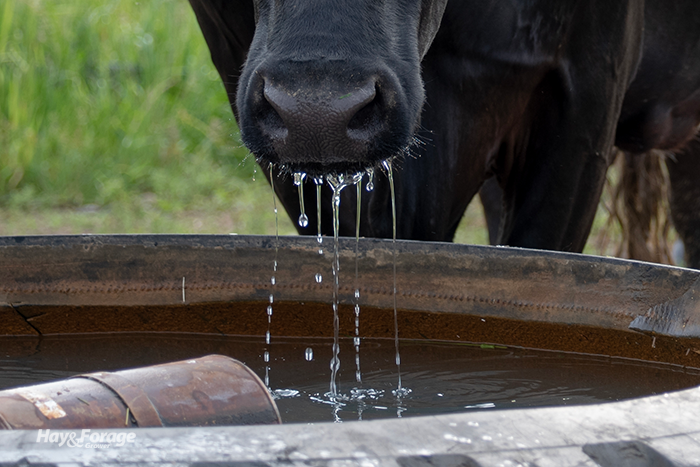
It was the Sons of the Pioneers who first brought the Western classic song “Cool Water” to the masses during the 1940s. It chronicled the story of a parched man and his donkey in search of cool, clear water as they traversed the desert while also being tormented by the devil’s mirages.
This time of year, you don’t need to be on the desert to experience scorching heat. Neither do your cows and calves that are otherwise on good, productive pasture. The bar to provide adequate and good-quality water to pastured cattle has officially risen.
Lactating cows need 2 gallons of water per 100 pounds of body weight per day, according to University of Nebraska Extension beef educators Troy Walz and Aaron Berger. Bulls and dry cows need 1 to 1.5 gallons of water per 100 pounds per day.
Although these are general guidelines, actual water needs are influenced by temperature, livestock class, animal weight, and stage of production. As the thermometer mercury rises, cows need more water. Cows with nursing calves need more water than dry cows, and as cattle gain weight, they also add to their water requirement.
The beef specialists note that spring-calving cows will need close to 20 to 24 gallons of water per day for themselves and another 5 to 10 gallons for their calf when air temperatures rise to uncomfortable levels.
Aside from a designated water source, some of an animal’s water requirements can be met from grazed forages. Nursing calves meet some of their daily water needs with their dam’s milk, but Walz and Berger assert it’s best to plan on making sure cattle have access to the full amount of good-quality water they need.
“It’s particularly important that calves are able to reach the water levels in a tank, especially in hot weather,” the beef specialists note. “If cows come into water first and drink a tank down, calves may struggle to get a drink if there is a slow recharge. In such cases, a creep watering system may be needed.”
Quality matters
Cattle performance can be affected by water intake, but water quality is also important for cattle health and performance.
Walz and Berger caution that nitrate concerns are elevated during drought conditions. The total intake limit for cattle is the combined amounts from both feed and water. A safe level of nitrate nitrogen (NO3N) in the water for cattle is less than 100 parts per million (ppm).
The sulfate upper limit for calves is less than 500 ppm (167 ppm sulfur as sulfate). For adult cattle, the upper limit is less than 1,000 ppm (333 ppm sulfur as sulfate).
The beef educators list the symptoms of nitrate poisoning to include brownish discoloration of the blood, difficult and rapid breathing, muscle tremors, low tolerance to exercise, incoordination, diarrhea, frequent urination, collapse, and death.
Blue-green algae can also be toxic to cattle; it typically grows in any stagnant water source, including lakes and ponds. Excess amounts of blue-green algae will make water look like someone has dumped in a bucket of light green or turquoise paint, according to Walz and Berger.
Warm temperatures and sunlight can cause algae to grow rapidly. The signs of blue-green algae poisoning in cattle include diarrhea, lack of coordination, labored breathing, seizures, convulsions, and possibly death. Routine cleaning of tanks and utilizing a copper sulfate treatment or chlorine treatment can help keep water tanks free from moss and algae.
If ponds are used to provide water, cattle standing in the water to discourage flies or walking through it to drink results in higher suspended solids in the water. The added nutrients from manure and urine may also encourage algae growth. Limiting cattle access to only a portion of a pond can reduce pond water contamination but won’t eliminate it.
Walz and Berger suggest pumping water from the deep part of a pond to a water tank. This will enable livestock producers to still utilize pond water while reducing the risk of cattle consuming blue-green algae.
As with forage and soil, testing the water that cattle have access to is a practical solution for avoiding any water-related quality problems. This includes all ponds and water tanks. Prior to collecting a sample, contact your lab for a test kit and collection instructions to ensure a representative sample is taken and that the lab can complete the analysis needed.

